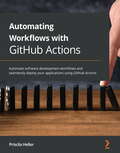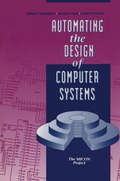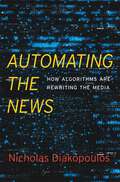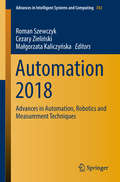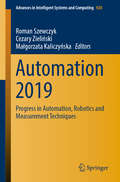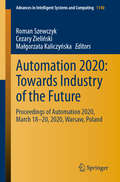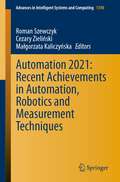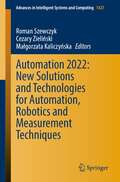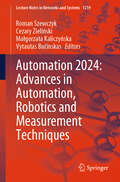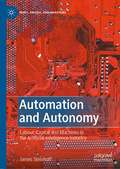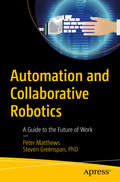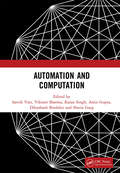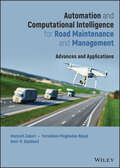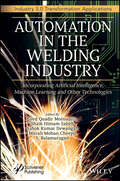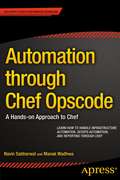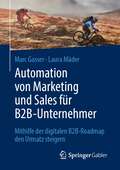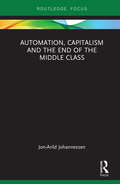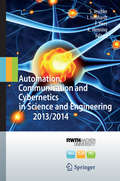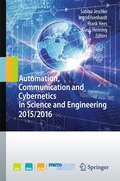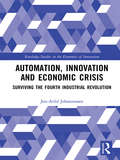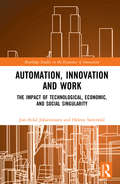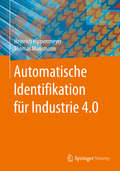- Table View
- List View
Automating Workflows with GitHub Actions: Automate software development workflows and seamlessly deploy your applications using GitHub Actions
by Priscila HellerBuild, test, and deploy code right from your GitHub repository by automating, customizing, and executing software development workflows with GitHub ActionsKey FeaturesEnhance your CI/CD and DevOps workflows using GitHub ActionsDiscover how to create custom GitHub Actions using Docker and JavaScriptGet up and running with building a CI/CD pipeline effectivelyBook DescriptionGitHub Actions is one of the most popular products that enables you to automate development tasks and improve your software development workflow. Automating Workflows with GitHub Actions uses real-world examples to help you automate everyday tasks and use your resources efficiently. This book takes a practical approach to helping you develop the skills needed to create complex YAML files to automate your daily tasks. You'll learn how to find and use existing workflows, allowing you to get started with GitHub Actions right away. Moving on, you'll discover complex concepts and practices such as self-hosted runners and writing workflow files that leverage other platforms such as Docker as well as programming languages such as Java and JavaScript. As you advance, you'll be able to write your own JavaScript, Docker, and composite run steps actions, and publish them in GitHub Marketplace! You'll also find instructions to migrate your existing CI/CD workflows into GitHub Actions from platforms like Travis CI and GitLab. Finally, you'll explore tools that'll help you stay informed of additions to GitHub Actions along with finding technical support and staying engaged with the community. By the end of this GitHub book, you'll have developed the skills and experience needed to build and maintain your own CI/CD pipeline using GitHub Actions.What you will learnGet to grips with the basics of GitHub and the YAML syntaxUnderstand key concepts of GitHub ActionsFind out how to write actions for JavaScript and Docker environmentsDiscover how to create a self-hosted runnerMigrate from other continuous integration and continuous delivery (CI/CD) platforms to GitHub ActionsCollaborate with the GitHub Actions community and find technical help to navigate technical difficultiesPublish your workflows in GitHub MarketplaceWho this book is forThis book is for anyone involved in the software development life cycle, for those looking to learn about GitHub Actions and what can be accomplished, and for those who want to develop a new skill to help them advance their software development career. If you are new to GitHub and GitHub Actions in general, then this book is for you. Basic knowledge of GitHub as a platform will help you to get the most out of this book.
Automating the Analysis of Spatial Grids: A Practical Guide to Data Mining Geospatial Images for Human & Environmental Applications (Geotechnologies and the Environment #6)
by Valliappa LakshmananThe ability to create automated algorithms to process gridded spatial data is increasingly important as remotely sensed datasets increase in volume and frequency. Whether in business, social science, ecology, meteorology or urban planning, the ability to create automated applications to analyze and detect patterns in geospatial data is increasingly important. This book provides students with a foundation in topics of digital image processing and data mining as applied to geospatial datasets. The aim is for readers to be able to devise and implement automated techniques to extract information from spatial grids such as radar, satellite or high-resolution survey imagery.
Automating the Design of Computer Systems
by Daniel P. Siewiorek William P. Birmingham Anurag P. GuptaAddressing the issues of engineering design in computer architecture, this book describes the design and implementation of MICON, a system for automating the synthesis of small computers.
Automating the News: How Algorithms Are Rewriting the Media
by Nicholas DiakopoulosFrom hidden connections in big data to bots spreading fake news, journalism is increasingly computer-generated. Nicholas Diakopoulos explains the present and future of a world in which algorithms have changed how the news is created, disseminated, and received, and he shows why journalists—and their values—are at little risk of being replaced.
Automation 2018: Advances In Automation, Robotics And Measurement Techniques (Advances In Intelligent Systems And Computing #743)
by Roman Szewczyk Małgorzata Kaliczyńska Cezary ZielińskiThis book consists of papers presented at Automation 2018, an international conference held in Warsaw from March 21 to 23, 2018. It discusses the radical technological changes occurring due to the INDUSTRY 4.0, with a focus on offering a better understanding of the Fourth Industrial Revolution. Each chapter presents a detailed analysis of interdisciplinary knowledge, numerical modeling and simulation as well as the application of cyber-physical systems, where information technology and physical devices create synergic systems leading to unprecedented efficiency. The theoretical results, practical solutions and guidelines presented are valuable for both researchers working in the area of engineering sciences and practitioners looking for solutions to industrial problems.
Automation 2019: Progress in Automation, Robotics and Measurement Techniques (Advances in Intelligent Systems and Computing #920)
by Roman Szewczyk Małgorzata Kaliczyńska Cezary ZielińskiThis book consists of papers presented at AUTOMATION2019, an international conference held in Warsaw from March 27 to 29, 2019. It discusses the radical technological changes occurring due to the INDUSTRY 4.0. To follow these changes, both scientists and engineers have to face the challenge of interdisciplinary approach directed at the development of cyber-physical systems. This approach encompasses interdisciplinary theoretical knowledge, numerical modelling and simulation as well as application of artificial intelligence techniques. Both software and physical devices are composed into systems that will increase production efficiency and resource savings. The theoretical results, practical solutions and guidelines presented are valuable for both researchers working in the area of engineering sciences and practitioners looking for solutions to industrial problems.
Automation 2020: Proceedings of Automation 2020, March 18–20, 2020, Warsaw, Poland (Advances in Intelligent Systems and Computing #1140)
by Roman Szewczyk Małgorzata Kaliczyńska Cezary ZielińskiThis book presents the scientific outcomes of the International Conference AUTOMATION 2020, held on March 18–20, 2020 in Warsaw, Poland. The next 30 years will see radical innovations in production processes, transportation management and social life. The changes brought about by the transformation to zero-emission industry require advances in many fields, but especially in industrial automation, robotics and measurement techniques associated with the cyber-physical systems employing artificial intelligence that will be key to reducing costs and enabling European society to maintain its quality of live. In this context, the book features the latest research toward further developing these fields of engineering, and also offers solutions and guidelines that are useful for both researchers and engineers addressing problems associated with the world of ongoing radical changes.
Automation 2021: Recent Achievements in Automation, Robotics and Measurement Techniques (Advances in Intelligent Systems and Computing #1390)
by Roman Szewczyk Małgorzata Kaliczyńska Cezary ZielińskiThis book contains 38 papers authored by both scientists and practitioners focused on an interdisciplinary approach to the development of cyber-physical systems. Recently our civilization has been facing one of the most severe challenges in modern history. The COVID-19 pandemic devastated the global economy and significantly disrupted numerous areas of economic activity. Only radical increase of efficiency and versatility of industrial production, with further limitation of human involvement, paralleled by the decrease of environmental burden, will enable us to cope with such challenges. We hope that the presented book provides input to the solution of at least some problems brought about by this challenge. This approach relies on the development of measuring techniques, robotic and mechatronic systems, industrial automation, numerical modeling and simulation as well as application of artificial intelligence techniques required by the transformation leading to Industry 4.0.
Automation 2022: New Solutions and Technologies for Automation, Robotics and Measurement Techniques (Advances in Intelligent Systems and Computing #1427)
by Roman Szewczyk Małgorzata Kaliczyńska Cezary ZielińskiThis book presents the unique result of discussion among interdisciplinary specialists facing recent industrial and economic challenges. It contains papers authored by both scientists and practitioners focused on an interdisciplinary approach to developing measuring techniques, robotic and mechatronic systems, industrial automation, numerical modelling and simulation, and application of artificial intelligence techniques required by the transformation leading to Industry 4.0. We strongly believe that the solutions and guidelines presented in this book will be useful to both researchers and engineers facing problems associated with developing cyber-physical systems for global development.
Automation 2024: Advances in Automation, Robotics and Measurement Techniques (Lecture Notes in Networks and Systems #1219)
by Roman Szewczyk Małgorzata Kaliczyńska Cezary Zieliński Vytautas BučinskasThis book presents the result of the most recent discussion among interdisciplinary specialists facing scientific and industrial challenges. The papers presented during the Automation 2024 Conference deal with applying artificial neural networks and other machine learning methods in perception, modelling, and control, utilization of fractional order systems, and novel sensors and measurement techniques. Recent developments in robotics and the quality of exerted control and optimization are also prominent in this volume. Specific aspects of the design of diverse robots and their modelling and control are described in depth. We strongly believe that the solutions and guidelines presented in this book will be useful to both researchers and engineers during the development of automation, robotics, and measurement systems in a rapidly changing global industry.
Automation Control Theory Perspectives in Intelligent Systems: Proceedings of the 5th Computer Science On-line Conference 2016 (CSOC2016), Vol 3 (Advances in Intelligent Systems and Computing #466)
by Radek Silhavy Roman Senkerik Zuzana Kominkova Oplatkova Petr Silhavy Zdenka ProkopovaThe volume Automation Control Theory Perspectives in Intelligent Systems presents new approaches and methods to real-world problems, and in particular, exploratory research that describes novel approaches in the field of cybernetics and automation control theory. Particular emphasis is laid on modern trends in intelligent information technology, system monitoring and proactive management of complex objects The 5th Computer Science On-line Conference (CSOC2016) is intended to provide an international forum for discussions on the latest high-quality research results in all areas related to Computer Science. The addressed topics are the theoretical aspects and applications of Computer Science, Artificial Intelligences, Cybernetics, Automation Control Theory and Software Engineering.
Automation and Autonomy: Labour, Capital and Machines in the Artificial Intelligence Industry (Marx, Engels, and Marxisms)
by James SteinhoffThis book argues that Marxist theory is essential for understanding the contemporary industrialization of the form of artificial intelligence (AI) called machine learning. It includes a political economic history of AI, tracking how it went from a fringe research interest for a handful of scientists in the 1950s to a centerpiece of cybernetic capital fifty years later. It also includes a political economic study of the scale, scope and dynamics of the contemporary AI industry as well as a labour process analysis of commercial machine learning software production, based on interviews with workers and management in AI companies around the world, ranging from tiny startups to giant technology firms. On the basis of this study, Steinhoff develops a Marxist analysis to argue that the popular theory of immaterial labour, which holds that information technologies increase the autonomy of workers from capital, tending towards a post-capitalist economy, does not adequately describe the situation of high-tech digital labour today. In the AI industry, digital labour remains firmly under the control of capital. Steinhoff argues that theories discerning therein an emergent autonomy of labour are in fact witnessing labour’s increasing automation.
Automation and Collaborative Robotics: A Guide to the Future of Work
by Peter Matthews Steven GreenspanUnderstand the current and future research into technologies that underpin the increasing capabilities of automation technologies and their impact on the working world of the future.Rapid advances in automation and robotics technologies are often reported in the trade and general media, often relying on scary headlines such as “Jobs Lost to Robots.” It is certainly true that work will change with the advent of smarter and faster automated workers; however, the scope and scale of the changes is still unknown. Automation may seem to be here already, but we are only at the early stages. Automation and Collaborative Robotics explores the output of current research projects that are improving the building blocks of an automated world. Research into collaborative robotics (cobotics) is merging digital, audio, and visual data to generate a commonly held view between cobots and their human collaborators. Low-power machine learning at the edge of the network can deliver decision making on cobots or to their manipulations. Topics covered in this book include: Robotic process automation, chatbots, and their impact in the near futureThe hype of automation and headlines leading to concerns over the future of workComponent technologies that are still in the research labsFoundational technologies and collaboration that will enable many tasks to be automated with human workers being re-skilled and displaced rather than replaced What You Will Learn Be aware of the technologies currently being researched to improve or deliver automationUnderstand the impact of robotics, other automation technologies, and the impact of AI on automationGet an idea of how far we are from implementation of an automated futureKnow what work will look like in the future with the deployment of these technologies Who This Book Is For Technical and business managers interested in the future of automation and robotics, and the impact it will have on their organizations, customers, and the business world in general
Automation and Computation: Proceedings of the International Conference on Automation and Computation, (AutoCom 2022), Dehradun, India
by Karan Singh Amit Gupta Satvik Vats Sharma Vikrant Dibyahash Bordoloi Navin GargThe proceedings of the International Conference on Automation and Computation 2022 (AUTOCOM-22) consist of complete research articles that were presented at the conference. Each of the research articles was double-blind reviewed by the experts of the corresponding domain. The book contains a blend of problems and respective solutions related to computer-based automation & computation to highlight the recent technological developments in computer-based automation. It serves as an environment for researchers to showcase the latest research results on Data Science & Engineering, Computing Technologies, Computational Intelligence, Communication & Networking, Signal & Image Processing, Intelligent Control Systems & Optimization, Robotics and Automation, Power, Energy & Power Electronics, Healthcare & Computation, AI for human interaction, etc. It aims to give deep insight into the current trends of research in science and technology and shall introduce the reader to the new problems and respective approaches toward the solution and shall enlighten the researchers, students and academicians about the research being carried out in the field.
Automation and Computational Intelligence for Road Maintenance and Management: Advances and Applications
by Amir H. Gandomi Hamzeh Zakeri Fereidoon Moghadas NejadAutomation and Computational Intelligence for Road Maintenance and Management A comprehensive computational intelligence toolbox for solving problems in infrastructure management In Automation and Computational Intelligence for Road Maintenance and Management, a team of accomplished researchers delivers an incisive reference that covers the latest developments in computer technology infrastructure management. The book contains an overview of foundational and emerging technologies and methods in both automation and computational intelligence, as well as detailed presentations of specific methodologies. The distinguished authors emphasize the most recent advances in the maintenance and management of infrastructure robotics, automated inspection, remote sensing, and the applications of new and emerging computing technologies, including artificial intelligence, evolutionary computing, fuzzy logic, genetic algorithms, knowledge discovery and engineering, and more. Automation and Computational Intelligence for Road Maintenance and Management explores a universal synthesis of the cutting edge in parameters and indices to evaluate models. It also includes: Thorough introductions to management science and the latest methods of automation and the structure and framework of automation and computing intelligence Comprehensive explorations of advanced image processing techniques, recent advances in fuzzy, and diagnosis automation Practical discussions of segmentation and fragmentation and different types of features and feature extraction methods In-depth examinations of methods of classification along with various developed methodologies and models of quantification, evaluation, and indexing in automation Perfect for postgraduate students in road and transportation engineering, evaluation, and assessment, Automation and Computational Intelligence for Road Maintenance and Management will also earn a place in the libraries of researchers interested in or working with the evaluation and assessment of infrastructure.
Automation and Utopia: Human Flourishing in a World without Work
by John DanaherAutomating technologies threaten to usher in a workless future, but John Danaher argues that this can be a good thing. A world without work may be a kind of utopia, free of the misery of the job and full of opportunities for creativity and exploration. If we play our cards right, automation could be the path to idealized forms of human flourishing.
Automation in the Welding Industry: Incorporating Artificial Intelligence, Machine Learning and Other Technologies (Industry 5.0 Transformation Applications)
by S. Balamurugan Ashok Kumar Dewangan Shaik Himam Saheb Syed Quadir Moinuddin Murali Mohan CheepuAUTOMATION IN THE WELDING INDUSTRY This volume serves as a multidimensional perspective of welding practices in Industry 5.0 from the perspective of automation, digitization, digital twins, cobots, virtual reality, augmented reality, machine learning, artificial intelligence, and IoT ranging from rudiments to advanced applications. This book introduces the concept of Industry 5.0 in welding technologies, where the human brain collaborates with robots to achieve rapid productivity and economic efficiency. It presents the latest information on adapting and integrating Industry 5.0 in welding industries through critical constituents such as artificial intelligence (AI), machine learning (ML), Internet of Things (IoT), digital twin, augmented and virtual reality (AR & VR), and collaborative robots (Cobots), towards intelligent welding systems. The chapter authors have comprehensively addressed the issues related to welding industries such as a shortage of welders, challenges in critical applications, creating defect-free and quality products through real-time monitoring, feedback systems, and in situ adjustments, etc. The utilization of cobots in welding technology is addressed in real-world problems to move towards a green welding environment (i.e., minimal fumes with less shielding gas) and thereby, less energy consumption. Two or more welding processes are combined to form a hybrid process where the compatibility of existing materials and novel materials can be used in 3D, 4D, and 5D printing of complex geometries. Audience Engineering research scholars, industry welding, and additive manufacturing groups. A diverse group of industries will be interested in this book, such as medical, automotive, construction, pipeline, shipping, aerospace, etc.
Automation through Chef Opscode: A Hands-on Approach to Chef
by Navin Sabharwal Manak WadhwaAutomation through Chef Opscode provides an in-depth understanding of Chef, which is written in Ruby and Erlang for configuration management, cloud infrastructure management, system administration, and network management. Targeted at administrators, consultants, and architect, the book guides them through the advanced features of the tool which are necessary for infrastructure automation, devops automation, and reporting. The book presumes knowledge of Ruby and Erlang which are used as reference languages for creating recipes and cookbooks and as a refresher on them to help the reader get on speed with the flow of book. The book provides step by step instructions on installation and configuration of Chef, usage scenarios of Chef, in infrastructure automation by providing common scenarios like virtual machine provisioning, OS configuration for Windows, Linux, and Unix, provisioning and configuration of web servers like Apache along with popular databases like MySQL. It further elaborates on the creation of recipes, and cookbooks, which help in deployment of servers and applications to any physical, virtual, or cloud location, no matter the size of the infrastructure. The books covers advanced features like LWRPs and Knife and also contains several illustrative sample cookbooks on MySQL, Apache, and CouchDB deployment using a step by step approach. What you'll learn Features and resources that power Chef as an optimum automation tool Installing and configuring Chef Managing your infrastructure using Chef How to develop cookbooks and recipes Real-time automation to deploy servers and applications to any physical, virtual, or cloud location Who this book is for IT administrators OS administrators Linux administrators Consultants Cloud architects Cloud computing consultants Infrastructure architects Automation consultants Automation architects Table of Contents Chapter 1 Introduction Chapter 2 The Chef Server Chapter 3 Installing and configuring the Chef Server Chapter 4 Installing and configuring a Workstation Chapter 5 Nodes Chapter 6 Knife Chapter 7 Cookbooks Chapter 8 Using Cookbooks Chapter 9 Develop a Complex Cookbook Chapter 10 Resource and Providers Chapter 11 HA Chapter 12 Cloud Provisioning with Vagrant and Chef Chapter 13 Troubleshooting
Automation von Marketing und Sales für B2B-Unternehmer: Mithilfe der digitalen B2B-Roadmap den Umsatz steigern
by Marc Gasser Laura MäderDie Automation von Marketing und Sales ist in Zukunft erfolgsentscheidend. Nur so können B2B-Unternehmen dem Wettbewerbsdruck weiterhin standhalten. Doch der Aufbau eines digitalen Marketing- und Salesprozesses ist aufwendig und komplex und stellt insbesondere kleinere B2B-Unternehmen vor die herausfordernde Frage: Wie kann die Digitalisierung möglichst kosteneffizient vorangetrieben werden? Anhand von Erfahrungswerten aus über 100 B2B-Digitalisierungsprojekten haben Laura Mäder und Marc Gasser das Modell der digitalen B2B-Roadmap entwickelt – eine Schritt-für-Schritt-Anleitung für die Planung, Steuerung und Skalierung von digitalem Marketing und Sales. Mithilfe der digitalen B2B-Roadmap Leads automatisiert entlang der Customer-Journey führen, einen Wettbewerbsvorteil erreichen und den Umsatz steigern. Dieses Buch ist für B2B-Unternehmer, Visionäre und Impulsgeber, die veraltete Marketing- und Salesmodelle auf den Kopf stellen und Innovation effizient vorantreiben wollen.
Automation, Capitalism and the End of the Middle Class (Routledge Focus on Economics and Finance)
by Jon-Arild JohannessenIn this book, the author argues that a new form of capitalism is emerging at the threshold of the Fourth Industrial Revolution. He asserts that we are in the midst of a transition from democratic capitalism to feudal capitalism and highlights how robotization and innovation is leading to a social crisis for the middle classes as economic inequality is on the rise. Johannessen outlines the three elements – Balkanization, the Great Illusion, and the plutocracy – which are referred to here as feudal structures. He describes, analyzes, and discusses these elements both individually and in interaction with each other, and asks: "What structures and processes are promoting and boosting feudal capitalism?" Additionally, the book serves to generate knowledge about how the middle class will develop in the Fourth Industrial Revolution. It shows the various effects of robotization on the middle class, where middle class jobs are transformed, deconstructed, and re-constructed and new part-time jobs are created for the middle class. Given the interest in the Fourth Industrial Revolution, the book will appeal to students of economic sociology and political economy as well as those in innovation and knowledge management courses focusing upon the emerging innovation economy. The topic will attract policymakers, and the accessible and engaging tone will also make the book of interest to the general public.
Automation, Communication and Cybernetics in Science and Engineering 2013/2014
by Sabina Jeschke Ingrid Isenhardt Frank Hees Klaus HenningThis book continues the tradition of its predecessors "Automation, Communication and Cybernetics in Science and Engineering 2009/2010 and 2011/2012" and includes a representative selection of scientific publications from researchers at the institute cluster IMA/ZLW & IfU. IMA - Institute of Information Management in Mechanical Engineering ZLW - Center for Learning and Knowledge Management IfU - Associated Institute for Management Cybernetics e. V. Faculty of Mechanical Engineering, RWTH Aachen University The book presents a range of innovative fields of application, including: cognitive systems, cyber-physical production systems, robotics, automation technology, machine learning, natural language processing, data mining, predictive data analytics, visual analytics, innovation and diversity management, demographic models, virtual and remote laboratories, virtual and augmented realities, multimedia learning environments, organizational development and management cybernetics. The contributions selected reflect the fundamental paradigm shift toward an increasingly interdisciplinary research world - which has always been both the basis and spirit of the institute cluster IMA/ZLW & IfU.
Automation, Communication and Cybernetics in Science and Engineering 2015/2016
by Sabina Jeschke Ingrid Isenhardt Frank Hees Klaus HenningAutomation, Communication and Cybernetics in Science and Engineering 2015/2016
Automation, Innovation and Economic Crisis: Surviving the Fourth Industrial Revolution (Routledge Studies in the Economics of Innovation)
by Jon-Arild JohannessenThe fourth industrial revolution is developing globally, with no geographical centre. It is also taking place at enormous speed. This development will shape the workplaces of the future, which will be entirely different from the workplaces created by the first, second and third industrial revolutions. Industry created the industrial worker. The knowledge society will create a new type of "industrial worker", the knowledge worker. While the third industrial revolution was concerned with the digitalization of work, in the fourth industrial revolution, robots will bring about the informatization of work. Many of these robots will be systematically connected, such that they can obtain updated information and learn from their own and others’ mistakes. The way we work, where we work, what we work on, and our relationships with our colleagues and employers are all in a state of change. The workplace of the future will not necessarily be a fixed geographical location, but may be geographically distributed and functionally divided. In his book, Jon-Arild Johannessen argues that a "perfect" social storm occurs when inequality grows at a catastrophic rate, unemployment increases, job security is threatened for a growing number and robotization takes over even the most underpaid jobs. Thus, the ingredients for a perfect social storm will be brought forward by cascades of innovations that will most likely lead to economic and social crises and he argues that it is reasonable to assume that it will only take a small spark for this social storm to develop into a social revolution.
Automation, Innovation and Work: The Impact of Technological, Economic, and Social Singularity (Routledge Studies in the Economics of Innovation)
by Jon-Arild Johannessen Helene SætersdalArtificial intelligence will not necessarily create a super-intelligent “human robot”; however, it is very probable that intelligent robots and intelligent informats will bring about a form of super-globalization, in which money and goods are prioritized over people and democracy and where the widespread use of casual labour – that is, short-term contracts – will become the most common form of employment relationship. It is also very likely that artificial intelligence will bring about what is known as singularity. This term is used to describe a situation where intelligent robots, from a rational and logical perspective, are smarter than humans, i.e. the development of AI. This book explores the impact that these intelligent robots and intelligent informats will have on social and societal development. The author tackles the question of singularity from three distinct standpoints: technological singularity – the intelligence of machines compared to that of humans – which he argues will bring about a qualitatively new labour market; economic singularity – the consequences for work relationships, value creation and employment – which he asserts will promote full automation, result in precarious contracts with low salaries, and, in some countries, possibly lead to the introduction of a universal basic income; and social singularity – the consequences of technological and economic singularity for democratic processes, bureaucratic procedures for exercising authority and control, and the direction in which society will develop, in addition to the emergence of new social institutions – which Johannessen says will promote a transition from representative democracy to genuine democracy. The book will appeal to academics, researchers and students of economic sociology and political economy, as well as those focusing upon the emerging innovation economy. It will also find an audience among professionals and policymakers keen to understand the impact the Fourth Industrial Revolution will have on organizations, individuals and society at large.
Automatische Identifikation für Industrie 4.0
by Heinrich Hippenmeyer Thomas MoosmannDie Autoren gehen in diesem Buch darauf ein, welche Herausforderungen mit "Industrie 4. 0" auf Industriepraktiker zukommen. Wie und mit welchen Zielsetzungen können Entwicklungen in mittelständischen Unternehmen aufgegriffen werden? Die Geräte zur automatischen Identifikation als Teil der Prozesssteuerung und Systemplanung der Intralogistik, zur Einbindung in das Netzwerk im Unternehmen und mit Partnern, sind Kumulationspunkte vieler Probleme in kleinen und mittelständischen Unternehmen. Diesen wird dargelegt wo und wie in den automatisierten Unternehmensbereichen Schritte zur "digitalen" Fabrik bereits vollzogen wurden und wie die Einbindung der betrieblichen Intralogistik in das firmenweite Netzwerk und damit in das ERP-System erfolgen kann.
